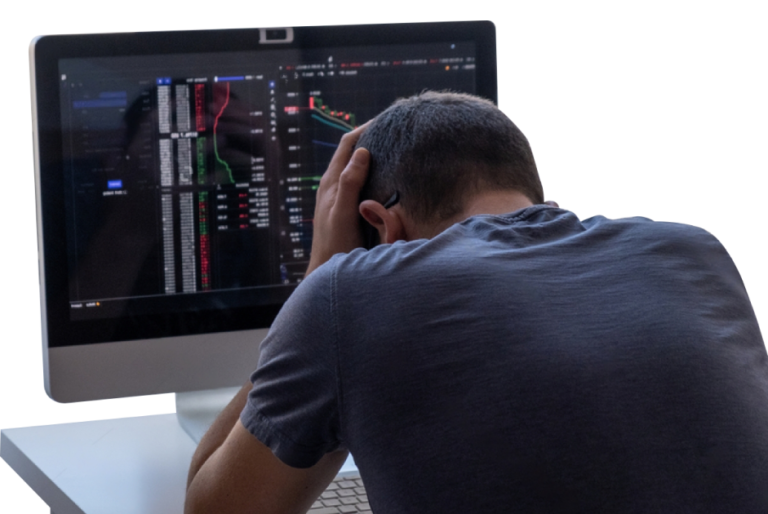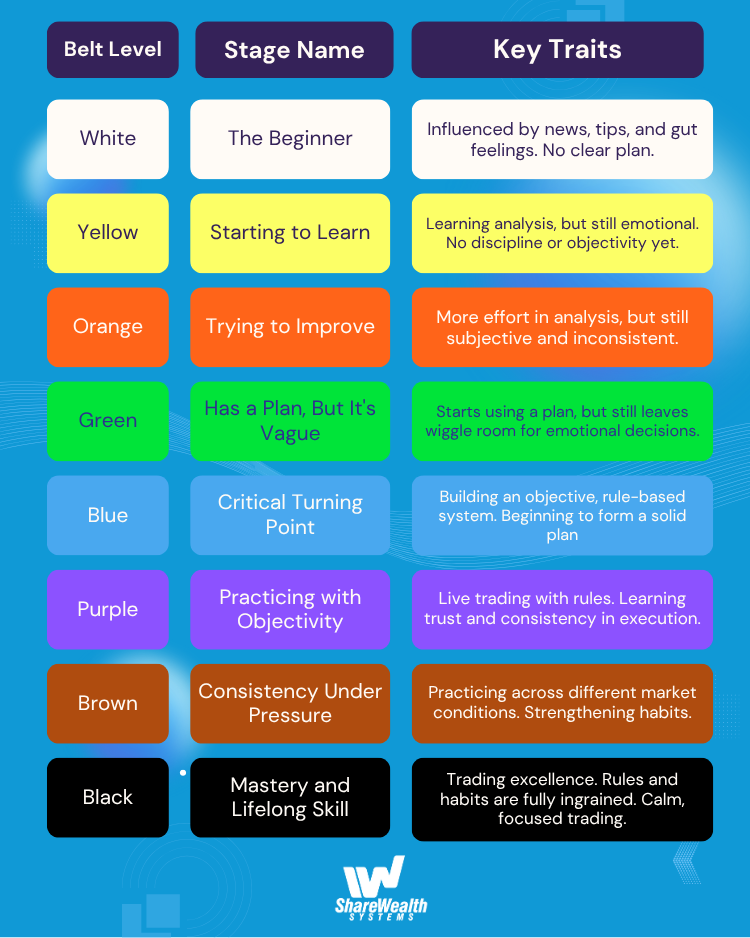
Overview:
Most traders don’t fail because of the market but because of how they trade. Chasing profits, making emotional decisions, and not following a clear system lead to inconsistency.
Trading mastery is like earning belts in martial arts; it takes time, discipline, and habit-building. Starting from beginner (White Belt) to expert (Black Belt), traders must learn structure, risk management, and focus on process over results.
The SPA3 system helps override guesswork by using clear, rules-based strategies built for long-term success. With the right habits, mindset, and support, anyone can build trading mastery and confidence over time.
Most traders don’t fail because of the markets. They fail because of how they trade. Market noise, political headlines, and economic news are often blamed, but the truth is harder to swallow: inconsistent results come from inconsistent habits. Traders usually fail due to how they trade and the lack of confidence in their trading system.
Most people focus on profits. But the truth is, profits are just the result. What matters is your approach, your habits, and your ability to stick to a solid system. Setting clear goals that align with your financial targets and risk appetite is essential to guide your trading strategies and develop good habits.
This article, based on insights from a recent trading mastery webinar, breaks down what trading mastery really means, how traders go from guessing to executing with confidence, and what it takes to build lifelong trading skill.
The Martial Arts Belt Analogy: From White to Black Belt

To help traders understand their growth, here’s a simple analogy of the martial arts belt system. It’s a simple way to show the similarities of building mastery in trading like a martial artist. It is a lifelong journey. You don’t go from beginner to expert overnight.
White Belt
This is the starting point. You’re new, relying on tips, news, and gut feelings. There’s no solid plan yet. For example, a White Belt might buy a stock just because they saw it mentioned on social media.
Yellow and Orange Belts
You start learning. Maybe you try out a few systems or strategies. But your decisions are still impulsive, and your results are inconsistent. Examples include following a trading plan for a few days, then abandoning it after a loss.
Green Belt
You have a plan now, but it’s still a bit loose. There’s too much room for guesswork, and that causes mistakes. For instance, a Green Belt might set stop losses but move them based on fear or hope.
Blue Belt
This is a key shift. You begin focusing on an objective “edge”. You’re building a system that overrides emotion and guesswork. An example is consistently following a set of entry and exit rules regardless of market noise.
Purple Belt
You start live trading with a system. You’re building trust in your system and in yourself. For example, a Purple Belt reviews trades weekly to identify and correct mistakes.
Brown Belt
You trade across different market conditions. You’re refining your habits and starting to see real consistency. An example is adapting your strategy to both trending and ranging markets while maintaining discipline.
Black Belt
This is mastery. You follow your system automatically . Your habits are solid, your execution is precise, and trading feels calm and focused. For example, a Black Belt executes trades without hesitation or second-guessing, even during volatile markets.
Check out this summary table of structured training progression below:

Introduction to Trading
Trading in the financial markets is both an art and a science, offering the potential to build wealth and achieve your financial goals.
Understanding the basics is the first step toward trading success. At its core, trading involves making investment decisions based on a combination of analysis, strategy, and discipline.
Risk Management: The Foundation of Every Belt Level
No matter where you are on your trading journey, risk management remains the cornerstone of long-term trading success. Even the best trading strategy can falter without a solid approach to managing risk.
Here are the key risk management principles for traders:
Know your risk tolerance
Understand how much risk you’re truly comfortable with. This helps you build a trading plan that aligns with your goals and limits emotional decision-making.
Set clear rules for every trade
Don’t trade based on gut feelings. Define entry, exit, stop loss, and size before entering any position.
Use trade-based risk management strategies
- Stop-loss orders act as a safety net, limiting your losses automatically.
- Position sizing ensures you never risk too much on a single trade.
Respect your stop-loss levels
Especially in the early stages, discipline around stop losses is critical. Avoid moving stops or ignoring them based on emotion.
Adapt techniques as you gain experience
As you progress, refine your risk management.
- Use risk-reward ratios to evaluate trade setups.
- Adjust position size based on market volatility and trade confidence.
- Implement trailing stops to protect gains and lock in profits as trades go your way.
Be especially cautious with leveraged markets
Instruments like futures can amplify both gains and losses. Risk management becomes even more crucial here
Focus on capital preservation
Great traders protect their capital first. Consistent profits follow those who weather through drawdowns and stay disciplined.
What Causes Trading Mistakes?
A lot of traders blame the market when things go wrong. Maybe it was unexpected news, or a bad stock pick. But the real cause of most trading mistakes is how you trade.
That means your decisions, your discipline, and your habits.
Here are the most common issues:
1. Subjective Trading
Many traders make decisions based on what feels right in the moment. They might follow gut instincts, social media posts, or breaking news instead of clear trade rules.
This kind of emotional decision-making leads to inconsistent results. Without an objective, rules-based plan, you’re reacting, not trading with purpose.
2. Inconsistent Execution
Even if you have a decent trading plan, it won’t work if you don’t follow it properly every time. Skipping steps or second-guessing your system confuses.
Successful trading is repeatable. If your actions change with every trade, your results will too
3. Bad Habits
Some traders ignore stop losses, move targets mid-trade, or keep changing systems. These habits feel safe in the moment, but slowly damage your consistency.
You need habits that support discipline, not ones that protect fear or avoid discomfort. Good trading habits are built with practice, not hope. Say goodbye to the bad habits and develop the skills to trade properly today.
4. Too Much Analysis, Not Enough Action
Many traders spend hours studying charts and indicators, but freeze when it’s time to act. They overthink and miss opportunities.
Learning to trade also means learning to act. Studying is important, but only if it leads to confident, timely execution.
5. Focusing on Profits Instead of Process
Chasing profits might give short-term motivation, but it often leads to forced trades or risky decisions. When the goal is just to make money, you lose sight of good execution.
Focusing on the process keeps you grounded. If you stick to your system and stay disciplined, profits will follow naturally over time.
The SPA3 System: Rules, Not Guesswork
The SPA3 system is a core part of Share Wealth Systems. It’s a rules-based system that overrides emotion from the equation. Every trade is based on clear, objective steps. Built for long-term trading, not short-term noise. This system is not intended for day trading, which requires a different approach, mindset, and risk management style.
This is ideal for traders who want a verified process or even those considering outsourcing investing through a time-tested system. Instead of relying on hunches, the SPA3 system helps you follow a method that’s already delivered years of performance.
What the system does:
- Uses volatility-adjusted trailing stops based on each stock’s movement.
- Trades last between 76 and 140 days.
- Works on the Beyond Charts platform, with alerts sent to your phone.
- Built for swing trading, not short-term noise.
How it performs:
- Around 54.7% win rate on Amazon trades, based on a combination of historical and live-trade data.
- Profit ratio of 4.5 to 1. Winning trades are much bigger than the losing ones.
- Expectancy of almost 2.0, which means it has a strong edge.
- In Australia, the system delivered a 26.5% return over 9.5 months, while the ASX 200 Accumulation Index returned 15.4% over the same period.
- In the U.S., the system achieved a long-term annualized return of 11.7%, likely measured over a period similar to the Australian data (approximately 9.5 years).
This system works because it’s not about guessing. It gives you a plan to follow, even when the market gets noisy.
The Path to Mastery: Skill, Execution, and Habit Building
Trading mastery isn’t about being smarter than everyone else. It’s about training. That means learning how to trade properly, sticking to your rules, and building habits that support your goals.
Here’s how the program helps:
- ‘Lived-experience’ training: You practice in real market conditions, not just in theory.
- Mentorship: You learn from traders who’ve already been through the ups and downs.
- Coaching: You get feedback on your habits, your execution, and what needs to improve.
Skills Acquisition Plan: You don’t just “wing it.” There’s a path, like moving up through belt levels.

The program also uses lessons from the book Atomic Habits to help traders replace bad habits with better ones. It’s not just about learning a system. It’s about becoming the kind of person who can follow one.
This kind of preparation is especially important now, when the retirement system no longer works for most people. Relying on traditional savings alone isn’t enough; building trading skills should now be a key part of your long-term financial independence. Visualizing your future and defining your goals can inspire you to take action and stay motivated on your trading journey.
Focus on Process, Not Profits
One of the biggest shifts traders need to make is moving away from focusing on money. It sounds strange, but chasing profits often leads to bad decisions. You might take trades you shouldn’t or skip ones you should take, just because you’re worried about the outcome.
Instead, focus on the process, especially when things get tough.
- Are you still following your rules when the market goes sideways?
- Are you staying consistent even during a drawdown?
- Are you managing risk properly when everything feels uncertain?
It’s easy to stick to your plan when markets are rising. But real discipline shows during the tough times; when trades aren’t going your way, when gains slow down, or when fear creeps in. That’s when focusing on the process matters most.
If you can answer yes to those questions, the profits will come. Maybe not right away, but over time.
Final Thoughts
If your trading feels inconsistent or stressful, the problem probably isn’t the market. It’s how you trade. That might sound tough to hear, but it’s also good news. Because if the issue is internal, it means you can fix it.
With the verified system, mentorship, and habits, you can go from guessing to trading with real confidence. You don’t have to be perfect. You just need to be committed to doing things the right way.
Mastery takes time. But it’s possible, and it starts with learning how to trade properly today!
Frequently Asked Questions
1. What’s the single biggest factor behind long-term trading success?
Long-term success comes from trading excellence, not chasing profits. This means developing strong habits, making disciplined decisions, and focusing on how you trade rather than trying to guess the market’s outcomes .
2. Why isn’t analysis alone enough to become a successful trader?
Studying charts and indicators helps, but it’s only one part of the equation. Real success comes from following a time-tested system and executing trades with consistency and discipline.
3. How can I stop making emotional trading mistakes?
The key is to follow a rules-based system with no wiggle room. This overrides emotion from the process and helps you stick to decisions even when the market gets noisy.
4. What kind of support helps most in learning to trade properly?
Mentorship, coaching, and live training are essential. Books and videos are helpful, but direct support helps you install good habits, stay accountable, and improve faster.
5. Is it too late to turn things around if I’ve failed before?
Not at all. With the right support, guidance, and mindset, any trader can reset their approach and work towards long-term consistency.
